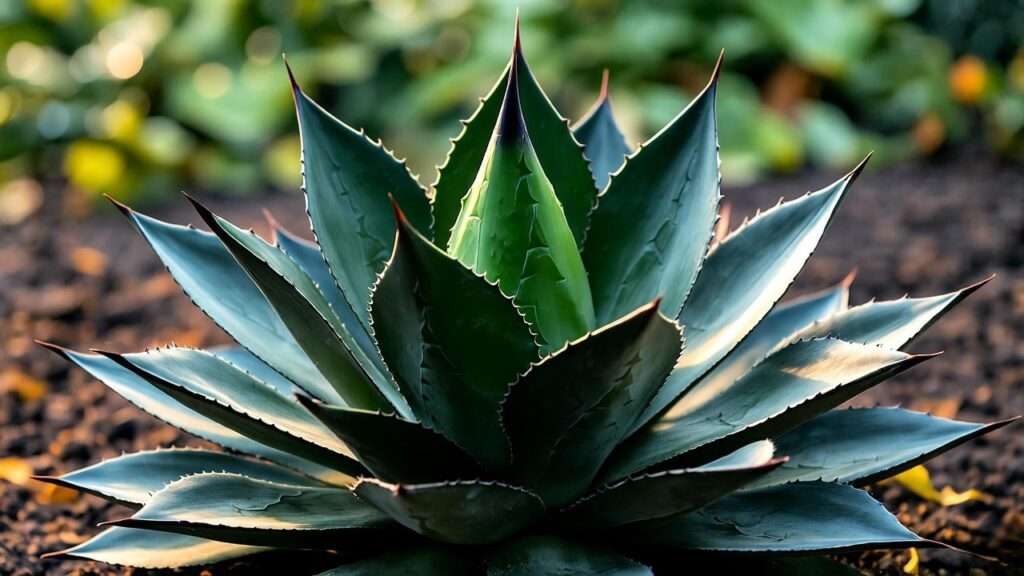Imagine transforming your garden or living space with a plant so striking it stops visitors in their tracks. The black agave plant, with its dramatic, near-black foliage and bold rosette shape, is that showstopper. This drought-tolerant succulent is a favorite among eco-conscious gardeners and indoor plant enthusiasts alike, offering low-maintenance beauty that thrives in arid conditions. Whether you’re a beginner or a seasoned plant parent, this comprehensive guide will equip you with expert tips to grow and care for your black agave plant successfully. From ideal lighting to propagation techniques, we’ve got you covered to ensure your succulent flourishes! 🌞
As a horticulturist with over a decade of experience cultivating succulents in diverse climates, I’ve seen firsthand how the black agave’s unique aesthetic elevates any space. This article draws on practical knowledge, research from botanical experts, and real-world gardening insights to deliver a definitive resource. Let’s dive into everything you need to know to keep your black agave thriving, sustainable, and stunning.
1. What Is a Black Agave Plant? 🌑
1.1 Overview of Black Agave 🌵
The black agave, often referring to varieties like Agave macroacantha ‘Black Spined’ or Agave nigra, is a striking succulent native to the arid regions of Mexico. Its dark, almost obsidian leaves form a compact, symmetrical rosette, typically reaching 1–2 feet in diameter. The plant’s sharp, spiky tips and deep coloration make it a standout in any garden or indoor setting. Unlike its larger cousin, the blue agave used for tequila, the black agave is prized for ornamental purposes, adding a modern, architectural vibe to landscapes.
Black agaves are part of the Asparagaceae family, known for their resilience in harsh, dry environments. Their ability to store water in thick leaves makes them a cornerstone of xeriscaping—landscaping designed to conserve water. Whether you’re drawn to their bold aesthetic or their eco-friendly nature, black agaves are a perfect blend of form and function.
1.2 Why Choose a Black Agave? ✨
Why opt for a black agave plant? For starters, its low-maintenance care suits busy gardeners and beginners. It thrives with minimal water, making it ideal for drought-prone regions or sustainable gardens. Its dark foliage creates a stunning contrast against lighter succulents, stones, or greenery, elevating garden designs. Indoors, it’s a chic addition to modern decor, fitting perfectly in minimalist or desert-inspired spaces.
I once worked with a client who transformed their small urban patio into a sleek xeriscape using black agave as the centerpiece. Paired with white gravel and lavender, the result was a low-water oasis that earned compliments from every neighbor. This plant’s versatility and striking presence make it a must-have for anyone seeking beauty with minimal effort.
2. Understanding the Needs of Your Black Agave 🌞
2.1 Light Requirements ☀️
Black agave plants crave bright light to maintain their vibrant, dark coloration. Outdoors, they thrive in full sun, soaking up at least 6 hours of direct sunlight daily. In hotter climates, partial shade during the afternoon prevents leaf scorch. For indoor growers, place your black agave near a south-facing window where it can bask in natural light. If natural light is limited, supplement with full-spectrum grow lights (aim for 10–12 hours daily).
A common mistake is underestimating light needs, which can cause the plant to stretch or lose its rich color. If your black agave’s leaves start to fade or elongate, relocate it to a brighter spot immediately. Pro tip: Rotate indoor pots every few weeks to ensure even light exposure, keeping the rosette symmetrical.
2.2 Soil and Drainage Essentials 🏜️
Proper soil is critical for black agave health. These succulents demand well-draining soil to prevent root rot, a common killer. Opt for a commercial cactus or succulent mix, or create your own by combining:
- 50% potting soil
- 30% coarse sand
- 20% perlite or pumice
This mix ensures excellent drainage and aeration. For garden planting, amend heavy clay soils with gravel or sand to mimic the plant’s native rocky terrain. Always use pots with drainage holes for indoor or container gardening—standing water is a black agave’s worst enemy. Expert tip: Add a layer of small pebbles on top of the soil for a polished look and extra drainage.
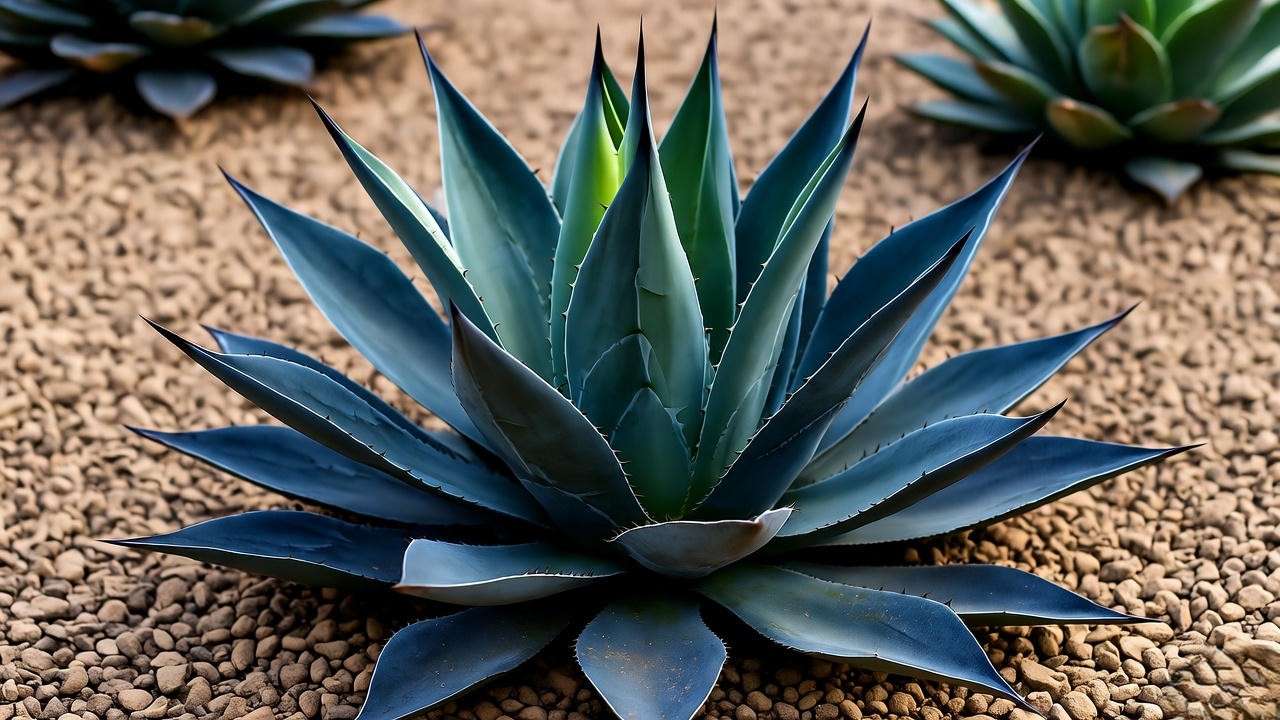
2.3 Watering Guidelines 💧
Watering a black agave plant is simple: less is more. During the growing season (spring and summer), water deeply every 2–3 weeks, ensuring the soil dries out completely between sessions. In fall and winter, reduce watering to once a month or less, as the plant enters dormancy. Overwatering can lead to root rot, signaled by soft, mushy leaves or a blackened base.
Use the “soak and dry” method: water thoroughly until it drains from the pot’s bottom, then wait until the soil is bone-dry before watering again. For outdoor plants, rainfall may suffice in wetter climates, but always check soil moisture. If you’re unsure, a moisture meter can help gauge when it’s time to water.
2.4 Temperature and Climate 🌡️
Black agaves thrive in temperatures between 60–85°F (15–29°C), though they can tolerate brief dips to 25°F (-4°C) if kept dry. In colder climates, bring potted plants indoors during winter or cover outdoor plants with frost cloths. These succulents excel in arid and semi-arid environments, making them ideal for regions like the Southwest U.S. or Mediterranean climates.
Indoor growers should avoid placing black agaves near drafty windows or heating vents, which can stress the plant. If you live in a humid climate, ensure extra drainage and airflow to prevent fungal issues. Their adaptability makes them a favorite for diverse growing conditions, from desert gardens to urban apartments.
3. Planting and Propagating Black Agave 🌱
3.1 How to Plant Black Agave 🪴
Planting a black agave is straightforward with the right approach. For containers:
- Choose a pot with drainage holes, slightly larger than the plant’s root ball (1–2 inches wider).
- Fill with a well-draining succulent mix.
- Place the agave so the base sits just above soil level to prevent rot.
- Water lightly and place in a bright, sunny spot.
For garden beds, select a sunny, well-drained location. Dig a hole twice the width of the root ball, mix in sand or gravel if needed, and plant at the same depth as in its nursery pot. Water sparingly for the first week to encourage rooting. Always wear gloves to handle the plant’s sharp spines safely.
Containers are ideal for flexibility, allowing you to move the plant indoors during cold snaps. Ground planting suits larger landscapes but requires excellent drainage to prevent water pooling.
3.2 Propagation Techniques 🌿
Black agaves are easy to propagate via offsets, or “pups,” which grow at the base of the mother plant. Here’s how to propagate:
- Locate Pups: Identify small rosettes with their own roots, typically 3–5 inches tall.
- Separate: Using gloves, gently twist or cut the pup from the parent with a sterilized knife.
- Dry: Let the pup’s cut end callous over for 2–3 days in a shaded, dry spot.
- Plant: Place the pup in a small pot with succulent soil, watering lightly every 5–7 days.
- Rooting: Roots form in 2–4 weeks; move to a permanent pot or garden spot once established.
Seed propagation is possible but slow and less reliable, requiring patience and precise conditions. Pups are the go-to method for most growers, offering a faster path to new plants. Expect 1–3 pups per mature black agave every few years.
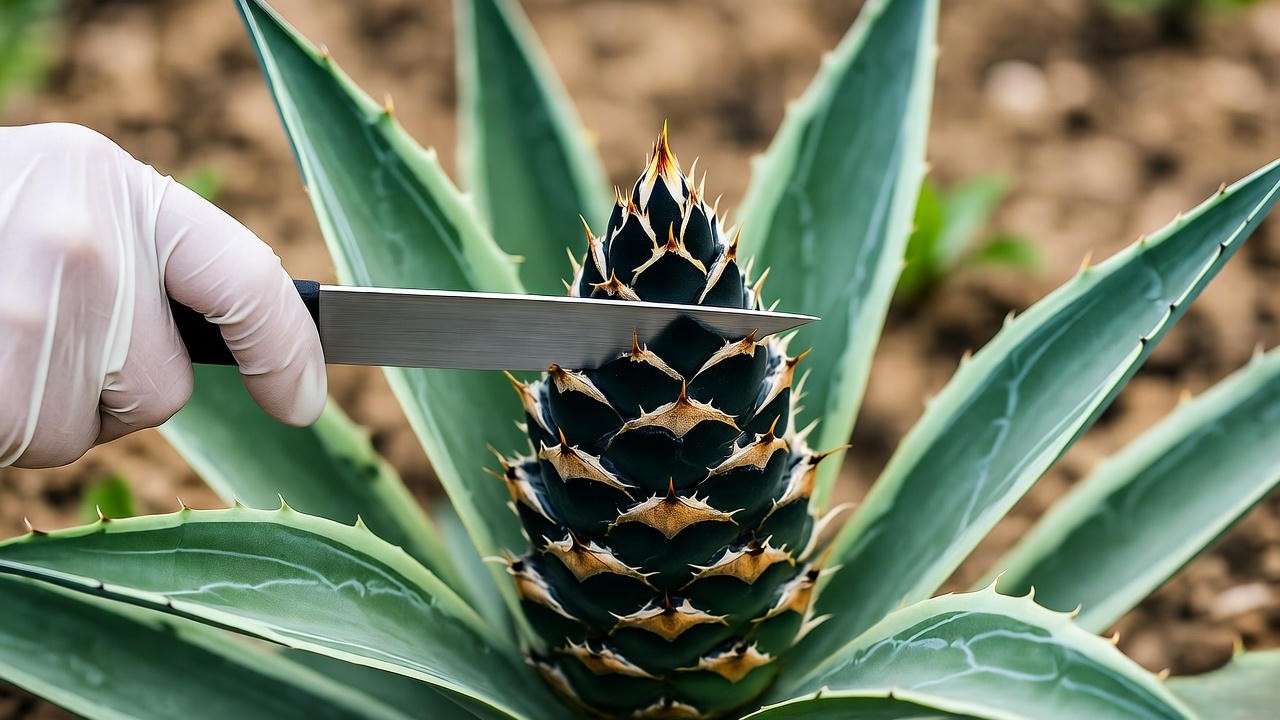
4. Ongoing Care and Maintenance 🛠️
4.1 Fertilizing Your Black Agave 🌼
Black agave plants require minimal fertilization, as overfeeding can harm their compact growth. Use a low-nitrogen, balanced fertilizer, such as a 10-10-10 or 5-10-5 formula, diluted to half strength. Apply it once or twice during the growing season (spring to early summer) to boost growth without overwhelming the plant. Liquid fertilizers or slow-release granules designed for cacti and succulents work best.
Spread the fertilizer evenly around the base, avoiding direct contact with the leaves to prevent burns. For outdoor plants, natural soil nutrients may suffice, especially in nutrient-rich xeriscapes. A common mistake is over-fertilizing, which can cause soft, elongated leaves or root damage. If you notice these signs, skip fertilizing for the season and flush the soil with water to dilute excess nutrients. Expert tip: If your black agave is thriving without fertilizer, skip it altogether—less is often more with succulents! 🌱
4.2 Pruning and Cleaning 🧹
Pruning a black agave is minimal but essential for aesthetics and health. Dead or dried lower leaves naturally occur as the plant grows. To remove them:
- Wear thick gloves to protect against spines.
- Use sterilized pruning shears to cut dead leaves close to the base, avoiding damage to healthy tissue.
- Dispose of debris to prevent pests from hiding in it.
For indoor plants, dust can accumulate on leaves, reducing photosynthesis. Gently clean the leaves with a soft, damp cloth or a small brush every few months. Avoid harsh chemicals or soaps, which can damage the plant’s waxy coating. Regular cleaning keeps your black agave looking vibrant and supports healthy growth. Pro tip: For a polished look, trim only the brown tips of leaves if they’re minorly damaged, maintaining the plant’s natural shape.
4.3 Repotting Tips 🪣
Repotting is necessary every 2–3 years or when the black agave becomes rootbound, indicated by roots circling the pot or slowed growth. Follow these steps:
- Choose a Pot: Select a new pot 1–2 inches larger in diameter with drainage holes.
- Prepare Soil: Use a fresh cactus or succulent mix for optimal drainage.
- Remove the Plant: Gently tap the pot to loosen the plant, holding it by the base with gloves.
- Inspect Roots: Trim any dead or damaged roots with sterilized shears.
- Repot: Place the plant in the new pot, filling with soil and ensuring the base sits just above soil level.
- Water Sparingly: Water lightly after 3–5 days to encourage rooting.
A common mistake is using pots without drainage, which traps moisture and risks rot. Terracotta pots are ideal for their breathability, especially in humid climates. If repotting to a larger garden bed, ensure the soil is well-draining and the plant is spaced 2–3 feet from others to allow for growth.
5. Troubleshooting Common Black Agave Problems 🐞
5.1 Pests and Diseases 🕷️
While black agaves are hardy, they can attract pests like mealybugs, scale, or spider mites. Check for these signs:
- Mealybugs: White, cottony patches on leaves or at the base.
- Scale: Small, brown, shell-like bumps on leaves.
- Spider Mites: Fine webbing or stippled, yellowing leaves.
To treat pests organically:
- Wipe leaves with a cloth dipped in 70% isopropyl alcohol to remove mealybugs or scale.
- Spray with neem oil or insecticidal soap every 7–10 days until pests are gone.
- For spider mites, increase humidity slightly and rinse leaves with water.
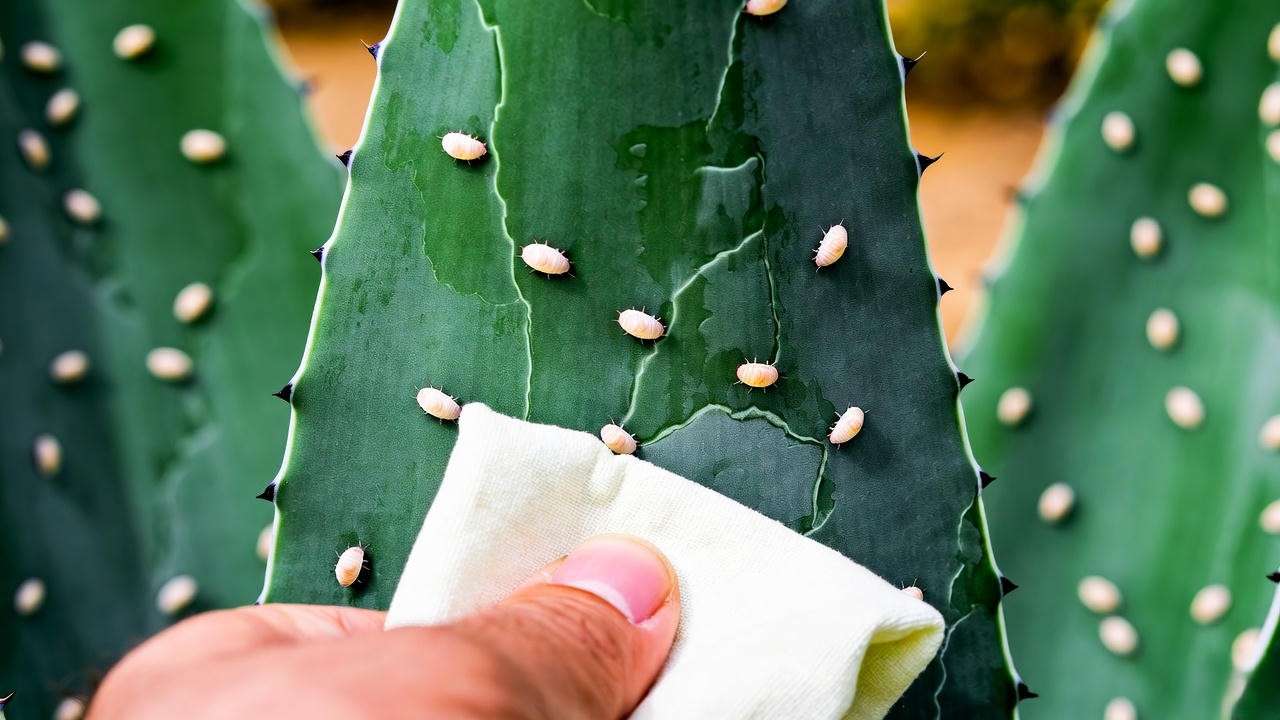
Fungal diseases, often caused by overwatering, are less common but dangerous. Root rot appears as blackened, mushy roots or a soft base. To prevent it, ensure proper drainage and avoid watering in cool, humid conditions. If rot occurs, remove affected roots, treat with a fungicide, and repot in fresh, dry soil. Regular inspections catch issues early, keeping your black agave healthy.
5.2 Growth Issues and Solutions 🌿
Common growth problems include yellowing leaves, stunted growth, or leaf tip burn. Here’s a quick troubleshooting guide:
| Issue | Cause | Solution |
|---|---|---|
| Yellowing leaves | Overwatering or poor drainage | Reduce watering; ensure soil dries out completely; check for root rot. |
| Stunted growth | Insufficient light or nutrients | Move to a brighter spot; apply diluted fertilizer once in spring. |
| Leaf tip burn | Sunburn or low humidity | Provide afternoon shade in hot climates; mist lightly in very dry conditions. |
| Soft, mushy leaves | Root rot from excess moisture | Cut away affected areas, repot in dry soil, and adjust watering schedule. |
For example, if your black agave’s leaves turn pale, it’s likely craving more sunlight. Relocate it to a sunnier spot or supplement with grow lights. Addressing issues promptly ensures your plant stays vibrant and healthy. Expert insight: Keep a care journal to track watering and light conditions, helping you pinpoint problems faster.
6. Design Ideas for Black Agave in Your Space 🏡
6.1 Incorporating Black Agave in Landscaping 🌄
Black agave’s bold form makes it a star in xeriscapes, rock gardens, or modern landscapes. Its dark foliage contrasts beautifully with light-colored stones, silver succulents like Echeveria, or vibrant grasses like blue fescue. Try these ideas:
- Focal Point: Plant a single black agave in a sea of white gravel for a minimalist, high-impact look.
- Rock Garden: Surround with boulders and low-growing succulents like sedum for texture.
- Pathway Accent: Line pathways with black agaves for a dramatic, structured border.
In a recent project, I designed a desert-inspired front yard with black agaves paired with yucca and lavender. The result was a water-wise, visually stunning landscape that required minimal upkeep. Space plants 2–3 feet apart to allow for growth and air circulation, especially in humid climates.
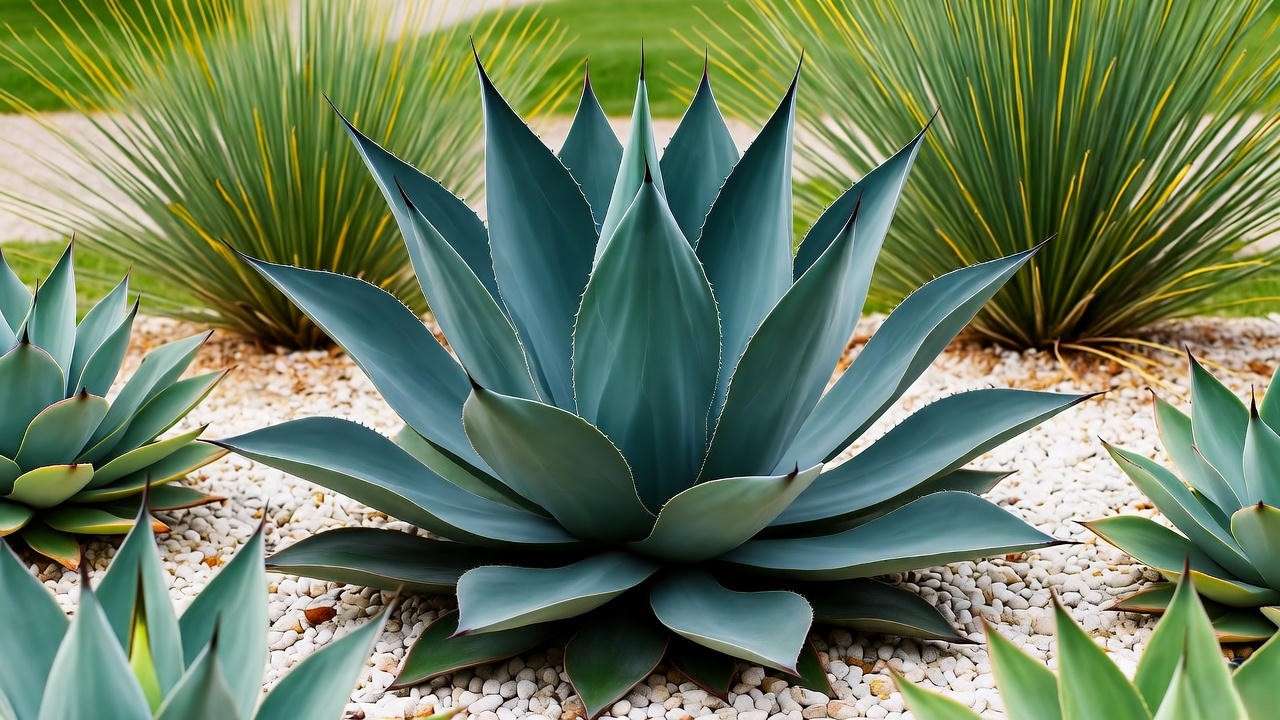
6.2 Indoor Styling with Black Agave 🪴
Indoors, black agaves shine in decorative pots or terrariums, adding a modern touch to any room. Here are some styling tips:
- Statement Piece: Place a black agave in a sleek, ceramic pot on a living room side table.
- Shelf Display: Pair with smaller succulents like haworthia for a curated look on a sunny shelf.
- Terrarium Focal: Use as the centerpiece in an open terrarium with pebbles and driftwood.
Choose pots that complement the plant’s dark hues, such as white, gray, or matte black. Ensure the pot has drainage holes, and place a saucer underneath to catch excess water. For a cohesive display, group with other succulents of varying heights and textures. Pro tip: Use a small mirror behind indoor plants to reflect light and enhance their visual appeal.
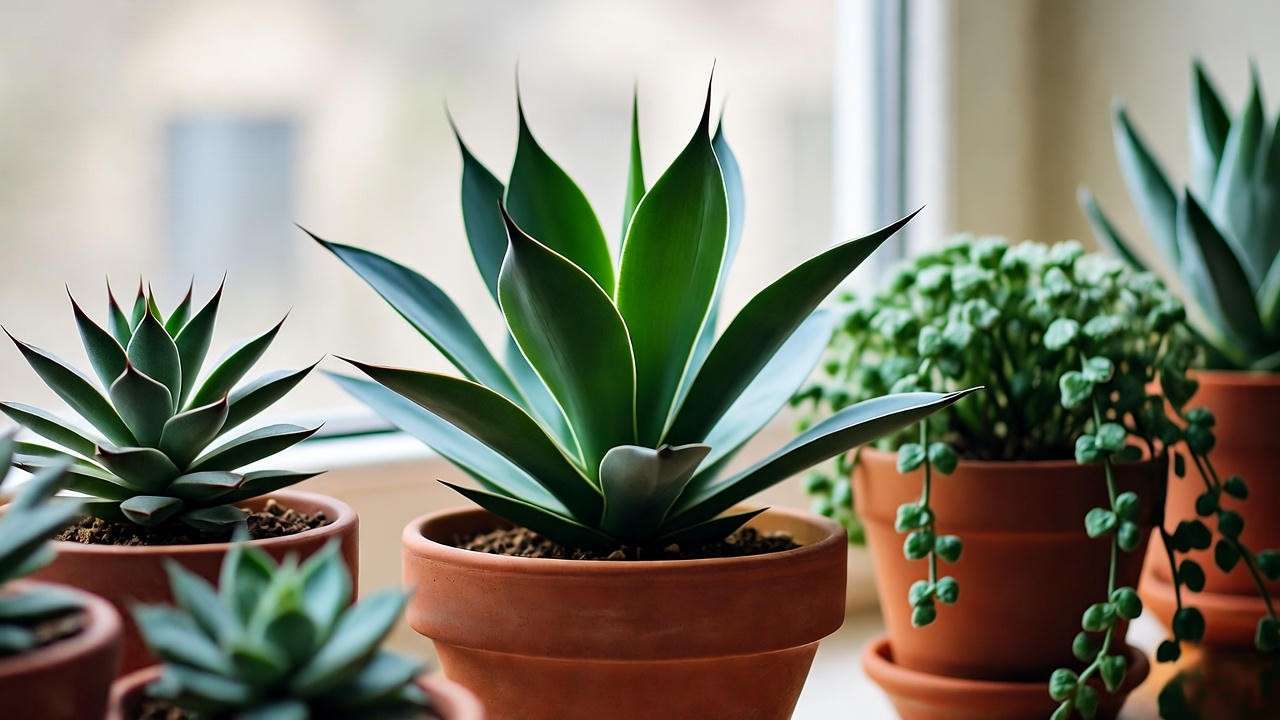
7. Expert Tips for Long-Term Success 🌟
To ensure your black agave thrives for years, follow these expert tips:
- Rotate Regularly: Turn potted plants every 2–3 weeks for even light exposure, preventing lopsided growth.
- Use Rainwater: If possible, collect rainwater for watering to mimic the plant’s natural environment and avoid mineral buildup.
- Monitor Seasonal Changes: Adjust care routines in winter, reducing water and protecting from frost.
- Sustainable Practices: Use recycled or terracotta pots to reduce environmental impact.
- Check Roots Annually: Inspect for rootbound conditions during repotting to maintain vigor.
- Prune Sparingly: Only remove dead leaves to preserve the plant’s natural shape.
- Observe and Adapt: Each plant is unique; tweak care based on your climate and plant’s response.
A horticulturist colleague once shared, “Black agaves are like the desert’s sculptures—resilient, elegant, and forgiving if you respect their needs.” With these tips, your black agave will remain a stunning, low-maintenance addition to your space.
8. Frequently Asked Questions (FAQs) ❓
- Q1: How often should I water my black agave plant?
Answer: Water every 2–3 weeks in summer, ensuring the soil dries out completely. In winter, water once a month or less during dormancy. - Q2: Can black agave survive indoors?
Answer: Yes, with bright light from a south-facing window or grow lights (10–12 hours daily). Ensure proper drainage and avoid overwatering. - Q3: Why are my black agave’s leaves turning yellow?
Answer: Yellowing often indicates overwatering or poor drainage. Check the soil, reduce watering, and ensure the pot has drainage holes. - Q4: Is black agave safe for pets?
Answer: Black agave is non-toxic but has sharp spines, so keep it out of reach of pets and children to avoid injury. - Q5: How long does a black agave live?
Answer: With proper care, black agaves can live 10–15 years, producing offsets for propagation to extend their legacy.
9. Conclusion and Call to Action 🌈
The black agave plant is more than just a succulent—it’s a bold, sustainable statement that elevates any garden or indoor space with minimal effort. By providing the right light, well-draining soil, and sparing water, you can enjoy its striking beauty for years. Whether you’re crafting a xeriscape masterpiece or styling a chic indoor display, this guide equips you with everything needed to grow a thriving black agave.
Ready to start your black agave journey? Put these tips into action and watch your plant flourish! Share your black agave setups in the comments or on social media with #BlackAgaveVibes—we’d love to see your creations. For more succulent care tips or xeriscaping ideas, explore our related articles on sustainable gardening and drought-tolerant plants. Happy planting! 🌵

